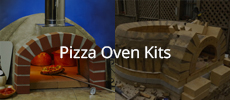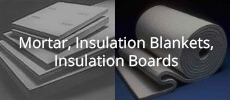I'm just starting to plan out building a refactory cast pizza oven. The access to my house is down a fairly small lane, and the garden is on a steep hill, so I figured casting something in place is going to be the easiest way to proceed. So far, I've cast the concrete slab next to the patio and almost finished the block-work for the walls of the base. I'm now just planning out how to proceed from here and finding I have lots of questions still.
Working from the bottom up, this is what I have planned at the moment:
Hollow concrete blocks sitting on a concrete slab as the base (completed now)
100mm reinforced concrete slab with weep holes
~10mm ceramic tiles with gaps between them for drainage
50mm ceramic fibre board for insulating under the floor
65mm fire bricks for oven floor
50mm thick inner dome, cast using heatproof screed (planning to use this product: https://www.vitcas.com/prd/heatproof-screed).
50mm ceramic fibre blanket
50mm outer render (either sand/cement or this stuff: https://www.vitcas.com/prd/outdoor-oven-cement)
My questions are as follows:
* Regarding the placement of weep holes in the base slab - should they line up under the insulation blanket? or it doesn't matter?
* Is it better to cast the slab with the holes or drill them afterwards? I can place in pieces of 10mm copper pipe when I'm casting, but then how would I level the slab if they're all sticking up?
* I'm assuming the idea for the mosaic tiles under ceramic fibre board is just to raise it off the concrete and allow any moisture to run out through the weep holes. I'm finding it difficult to source suitable mosaic tile sheets locally (and they're quite expensive), can I just glue down broken pieces of tiles with spaces between them instead?
* Should the ceramic board extend under the insulation blanket, or just the inner walls?
* Refactory cememt - I don't trust myself to make my own homebrew, so I'm thinking of using this product (https://www.vitcas.com/prd/heatproof-screed), they sell a bunch of similar looking products including one called 'outdoor oven cement', but I think the heatproof screed is the one to use for the inner dome. Has anyone used these before? Would I need to add fibres to this? Anything else I should consider?
* I've seen people mention some kind of vent/valve at the top of the dome, but I can't find which build this was on now - presumably this is just in the outer render layer (venting from the insulation blanket to the outside), not extending into the inner dome? what kind of valve is this, and where can I buy one?
* This seems a long way into the future, but for the outer render (on top of the insulation blanket), should that be a specialist mix (like the outdoor oven cement mentioned above), or just sand/cement?
* I don't really have the space to build a full enclosure for the oven, but assuming I have some kind of vent/valve between the insulation and the outside, is there any reason not to completely water-proof the outside (either with some kind of masonry weatherproofing cream, or tanking slurry or something else)?
Thanks in advance for any help and advice with this!
Working from the bottom up, this is what I have planned at the moment:
Hollow concrete blocks sitting on a concrete slab as the base (completed now)
100mm reinforced concrete slab with weep holes
~10mm ceramic tiles with gaps between them for drainage
50mm ceramic fibre board for insulating under the floor
65mm fire bricks for oven floor
50mm thick inner dome, cast using heatproof screed (planning to use this product: https://www.vitcas.com/prd/heatproof-screed).
50mm ceramic fibre blanket
50mm outer render (either sand/cement or this stuff: https://www.vitcas.com/prd/outdoor-oven-cement)
My questions are as follows:
* Regarding the placement of weep holes in the base slab - should they line up under the insulation blanket? or it doesn't matter?
* Is it better to cast the slab with the holes or drill them afterwards? I can place in pieces of 10mm copper pipe when I'm casting, but then how would I level the slab if they're all sticking up?
* I'm assuming the idea for the mosaic tiles under ceramic fibre board is just to raise it off the concrete and allow any moisture to run out through the weep holes. I'm finding it difficult to source suitable mosaic tile sheets locally (and they're quite expensive), can I just glue down broken pieces of tiles with spaces between them instead?
* Should the ceramic board extend under the insulation blanket, or just the inner walls?
* Refactory cememt - I don't trust myself to make my own homebrew, so I'm thinking of using this product (https://www.vitcas.com/prd/heatproof-screed), they sell a bunch of similar looking products including one called 'outdoor oven cement', but I think the heatproof screed is the one to use for the inner dome. Has anyone used these before? Would I need to add fibres to this? Anything else I should consider?
* I've seen people mention some kind of vent/valve at the top of the dome, but I can't find which build this was on now - presumably this is just in the outer render layer (venting from the insulation blanket to the outside), not extending into the inner dome? what kind of valve is this, and where can I buy one?
* This seems a long way into the future, but for the outer render (on top of the insulation blanket), should that be a specialist mix (like the outdoor oven cement mentioned above), or just sand/cement?
* I don't really have the space to build a full enclosure for the oven, but assuming I have some kind of vent/valve between the insulation and the outside, is there any reason not to completely water-proof the outside (either with some kind of masonry weatherproofing cream, or tanking slurry or something else)?
Thanks in advance for any help and advice with this!





 For the weep holes, I think it's easier to cast in place rather than drill later. Set a pattern of five pieces of pipe slightly below the projected surface of the hearth slab and under the oven floor footprint. Put a cotton ball or paper towel plug at the top of each pipe to reduce/eliminate concrete flowing into the pipe when you pour. These pipe pieces would obviously pass through your form base. Doing it that way allows you to pour, level, and avoid hitting rebar if you'd chosen to drill.
For the weep holes, I think it's easier to cast in place rather than drill later. Set a pattern of five pieces of pipe slightly below the projected surface of the hearth slab and under the oven floor footprint. Put a cotton ball or paper towel plug at the top of each pipe to reduce/eliminate concrete flowing into the pipe when you pour. These pipe pieces would obviously pass through your form base. Doing it that way allows you to pour, level, and avoid hitting rebar if you'd chosen to drill.  Once the concrete has set, you slide a piece of rod or sturdy screwdriver up the pipe tubes from below and tap out the plug and thin layer of concrete at the surface. This will also create a little divot around the weep hole to help any moisture gather & exit. If you can't find any porcelain/glass tile sheet squares, using broken pieces of tile would work just fine. Simply remember you want to provide a moisture block between the concrete slab and the insulation board (hence the use of glass or porcelain tile) and create both support for the board while allowing channels to the weep holes.
Once the concrete has set, you slide a piece of rod or sturdy screwdriver up the pipe tubes from below and tap out the plug and thin layer of concrete at the surface. This will also create a little divot around the weep hole to help any moisture gather & exit. If you can't find any porcelain/glass tile sheet squares, using broken pieces of tile would work just fine. Simply remember you want to provide a moisture block between the concrete slab and the insulation board (hence the use of glass or porcelain tile) and create both support for the board while allowing channels to the weep holes.
Comment